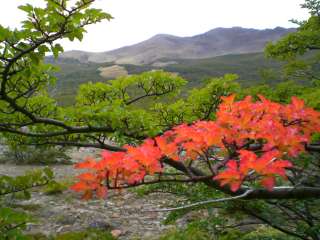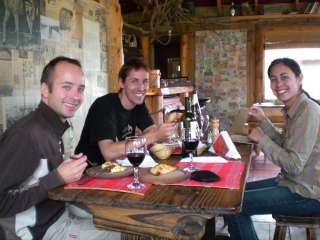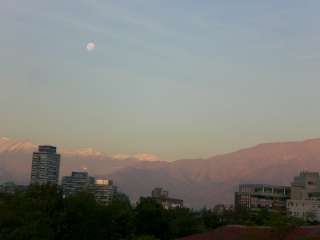 It’s no secret that the people of Argentina and Chile adore their meat. It is available everywhere, on every menu, in several different forms, served day and night, and almost always grilled to well done. I wouldn’t want to be an animal in South America as it’s only a matter of time before you end up on a menu.
It’s no secret that the people of Argentina and Chile adore their meat. It is available everywhere, on every menu, in several different forms, served day and night, and almost always grilled to well done. I wouldn’t want to be an animal in South America as it’s only a matter of time before you end up on a menu.
At a grocery store in Mendoza on a Saturday, a riot* of people had gathered around a meat counter that was struggling to keep up with the orders being shouted to the back. Meat is serious business and a good butcher, we’re told, is highly coveted and his address is held close to the chest. In Argentina, I thought I had reached the limit of my carnivorous consumption, but I was dead wrong; that was just the beginning.
Today’s lunch in the pretty Bellavista neighbourhood of Santiago consisted almost entirely of meat. We ordered the parrilla special for 2 and what landed on our table would’ve easily served six. Imagine a 9×9” square casserole dish filled to heaping with 2 big, grilled pork chops, 1 large, grilled steak, 2 blood sausages, 1 spicy chorizo sausage, 2 huge, grilled chicken breasts, and 2 large, boiled potatoes. That was lunch. There was some thyme on the chicken, and there was a salt shaker on the table, but that was all the seasoning that appeared. Luckily, a stray dog sleeping the shade of the next table was only too happy to eat most of what remained on my plate while the waiter wasn’t looking.
*Speaking of riots, it turns out that there was some serious rioting in Santiago the day we arrived. It was the annual Day of The Young Commbatents riot/protest staged in memory of the 1985 student riots during which many students were killed. This year’s anniversary protest was aggravated, we’re told, by some discontent with recent public transportation changes. At any rate, our afternoon arrival at the bus station, metro ride and walk through part of the downtown area was entirely uneventful; we didn’t sense the slightest whiff of unease. When we arrived at our hostel, one of the guys staying there asked, “What are the streets like out there- is it madness?” Of course we didn’t know what he was talking about and it was then that the hostel worker said that yes, there were riots, and that perhaps we should stay in the hostel that evening. The next morning, the news showed this. Santiago makes two cities now that we have visited while riots were in progress and we didn’t even know it. (The other was Budapest in September.) Stupid foreigners.
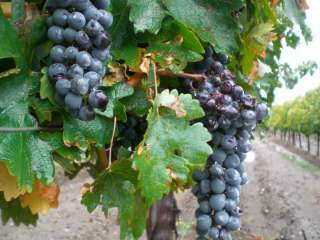
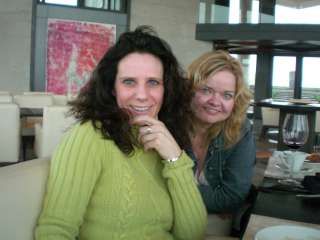
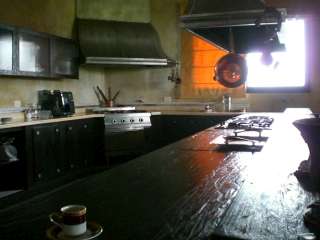 Andeluna, the second vineyard, was a little bigger. The suburban-country tasting room was warm, though a little contrived. We tried five wines with the 2005 Malbec and the 2003 Pasionado Blends being our favorites.
Andeluna, the second vineyard, was a little bigger. The suburban-country tasting room was warm, though a little contrived. We tried five wines with the 2005 Malbec and the 2003 Pasionado Blends being our favorites.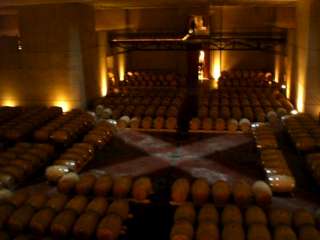
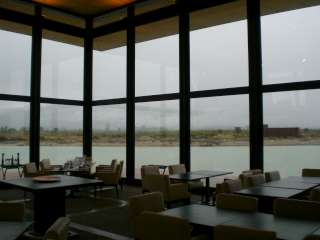
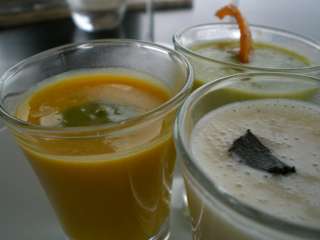
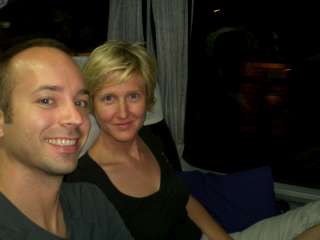 Thanks to
Thanks to 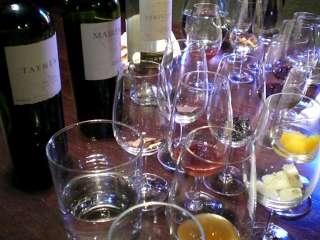 The special tasting room (!!) was prepared with three different, non-blended local wines: a Torrontes, a Bonarda and a Malbec. However, in addition to the wines, there were tasting glasses filled with the flavours that one is meant to experience in each wine. For example, the glass of Bonarda was accompanied by a glass each of earth, dried leaves, quince jam, and pepper. So, after one swirls and takes notes on the wines appearance, one is meant to sniff the aroma and compare it to the raw elements. How much fun is THAT!
The special tasting room (!!) was prepared with three different, non-blended local wines: a Torrontes, a Bonarda and a Malbec. However, in addition to the wines, there were tasting glasses filled with the flavours that one is meant to experience in each wine. For example, the glass of Bonarda was accompanied by a glass each of earth, dried leaves, quince jam, and pepper. So, after one swirls and takes notes on the wines appearance, one is meant to sniff the aroma and compare it to the raw elements. How much fun is THAT!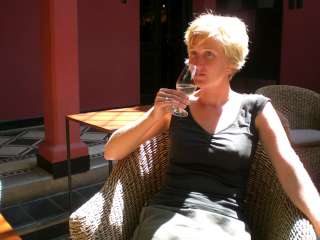 In my present state of mind*, I find it hard to imagine a better place in the world than Mendoza. They get 300 days of sun a year, the city is filled with huge, gorgeous trees, parillas (Argentine BBQ restaurants which universally serve gargantuan steaks) hover around almost every corner, and they are surrounded by wineries. Oh, and they’re within spitting distance of the Andes, not that I would ever spit wine.
In my present state of mind*, I find it hard to imagine a better place in the world than Mendoza. They get 300 days of sun a year, the city is filled with huge, gorgeous trees, parillas (Argentine BBQ restaurants which universally serve gargantuan steaks) hover around almost every corner, and they are surrounded by wineries. Oh, and they’re within spitting distance of the Andes, not that I would ever spit wine.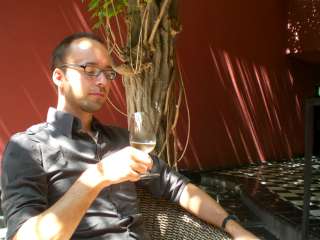 Anyway, I could go on and on about the wine but will limit myself here to talking about one particular wine tasting facility: Vines of Mendoza. I don’t really know how to label this place; it’s sort of a wine club, tasting room, wine-tour arranger, enthusiasts’ meeting place, wine promoter type place. (They make money by exporting local wines to Europe and America.) But for us, it’s just a great, relaxed place to go to taste, and learn about wine.
Anyway, I could go on and on about the wine but will limit myself here to talking about one particular wine tasting facility: Vines of Mendoza. I don’t really know how to label this place; it’s sort of a wine club, tasting room, wine-tour arranger, enthusiasts’ meeting place, wine promoter type place. (They make money by exporting local wines to Europe and America.) But for us, it’s just a great, relaxed place to go to taste, and learn about wine.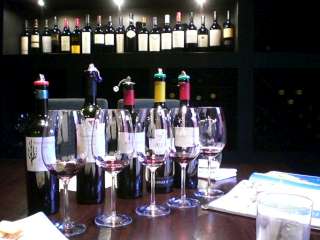 The hour and a half that followed was magnificent. We tasted five of Argentina’s Best wines, complete with an educated and friendly host who walked us through the regions, the varietals, the aging, the aromas and the tasting. (I’m edumacated in the wine, now.) After being so long in Asia without a drop of decent wine to be found, this was an absolutely exquisite way to spend the afternoon.
The hour and a half that followed was magnificent. We tasted five of Argentina’s Best wines, complete with an educated and friendly host who walked us through the regions, the varietals, the aging, the aromas and the tasting. (I’m edumacated in the wine, now.) After being so long in Asia without a drop of decent wine to be found, this was an absolutely exquisite way to spend the afternoon.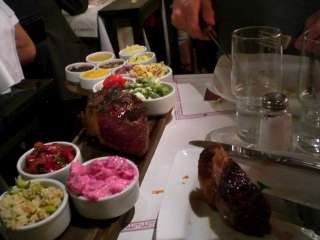 Two random couples we met raved about La Cabrera, a barbeque restaurant in Buenos Aries, one fellow saying he would return to BA just to go there. We showed up at 9pm, an early arrival by Argentinian standards, just to ensure we could get a seat without waiting, which we barely managed.
Two random couples we met raved about La Cabrera, a barbeque restaurant in Buenos Aries, one fellow saying he would return to BA just to go there. We showed up at 9pm, an early arrival by Argentinian standards, just to ensure we could get a seat without waiting, which we barely managed.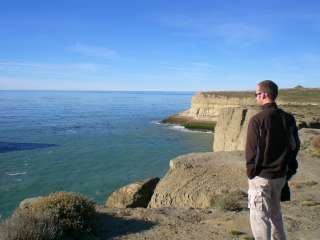 We stopped first at a lookout over the ocean and the island owned and operated by the migratory cormorants. Guano was mined here for European fertilizer until about 1930 and judging by the smell, the birds have worked hard since then to replenish the supply. Fortunately, we had our trusty binoculars and so were able to see a fair bit of avian activity before setting up our cold breakfast in the picnic hut upwind of the island. After breakfast, we decided to take a crack at seeing los penguinos. I was not optimistic because it was so warm, I thought for sure they’d be on their way someplace cooler now and would have abandoned their colony. Plus, the hike through the desert to reach the colony did not inspire confidence for a viewing. This sign was so randomly placed as to seem a joke.
We stopped first at a lookout over the ocean and the island owned and operated by the migratory cormorants. Guano was mined here for European fertilizer until about 1930 and judging by the smell, the birds have worked hard since then to replenish the supply. Fortunately, we had our trusty binoculars and so were able to see a fair bit of avian activity before setting up our cold breakfast in the picnic hut upwind of the island. After breakfast, we decided to take a crack at seeing los penguinos. I was not optimistic because it was so warm, I thought for sure they’d be on their way someplace cooler now and would have abandoned their colony. Plus, the hike through the desert to reach the colony did not inspire confidence for a viewing. This sign was so randomly placed as to seem a joke.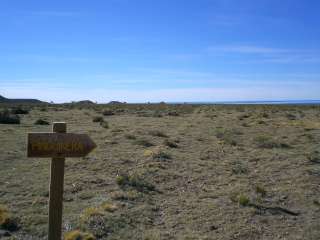
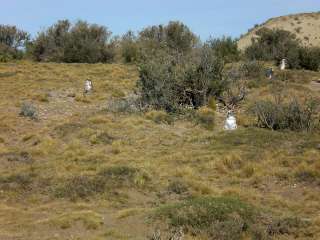
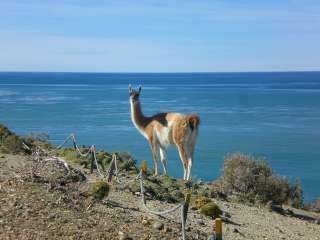
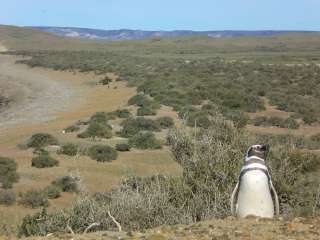
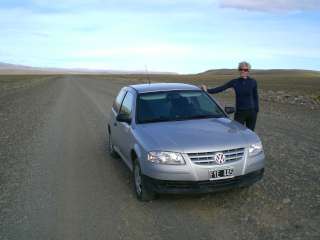 So, we rented a cute little Volkswagen, bought a map and a bunch of groceries and fired out onto the 297km gravel road that forms the majority of the connection between El Calafate and Puerto Santa Cruz. I don’t think I’ve ever been so much in the middle of nowhere as we were when we hit that gravel road.
So, we rented a cute little Volkswagen, bought a map and a bunch of groceries and fired out onto the 297km gravel road that forms the majority of the connection between El Calafate and Puerto Santa Cruz. I don’t think I’ve ever been so much in the middle of nowhere as we were when we hit that gravel road. 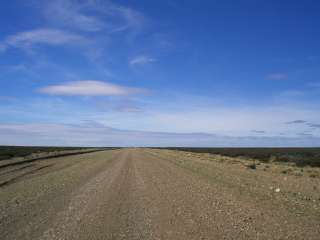
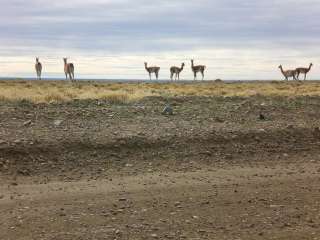 There were the usual suspects of rabbits and sheep, skunks and hawks, but there were also herds and herds of guanacos (sort of like llamas but less fuzzy) and a large bird whose name I don’t know but who looks and runs like an ostrich. Most fantastic of all, we saw a condor. I think we are exceptionally lucky to have spotted it on the side of the road right next to the huge river valley; it took off and floated on a thermal wind up and over and around our car for about 5 minutes. That bird is astonishingly large and to see it fly like that was amazing; this picture, nor my words, can hardly do it justice. We were agog.
There were the usual suspects of rabbits and sheep, skunks and hawks, but there were also herds and herds of guanacos (sort of like llamas but less fuzzy) and a large bird whose name I don’t know but who looks and runs like an ostrich. Most fantastic of all, we saw a condor. I think we are exceptionally lucky to have spotted it on the side of the road right next to the huge river valley; it took off and floated on a thermal wind up and over and around our car for about 5 minutes. That bird is astonishingly large and to see it fly like that was amazing; this picture, nor my words, can hardly do it justice. We were agog.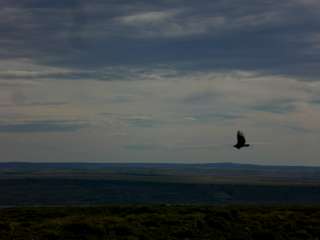
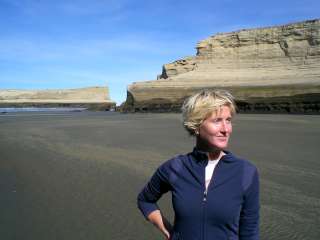 At any rate, this allowed us to spend one full, sunny day at the stunning national park next door and also forced us to sleep in the car that night. It wasn’t nearly as bad as I thought it would be: a quiet campground, a great view, a couple bottles of wine with our picnic… who knew I’d ever be so happy to sleep in a Golf?
At any rate, this allowed us to spend one full, sunny day at the stunning national park next door and also forced us to sleep in the car that night. It wasn’t nearly as bad as I thought it would be: a quiet campground, a great view, a couple bottles of wine with our picnic… who knew I’d ever be so happy to sleep in a Golf?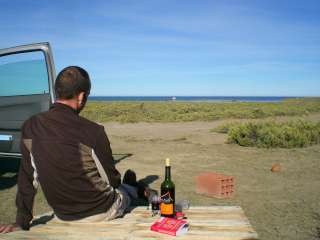
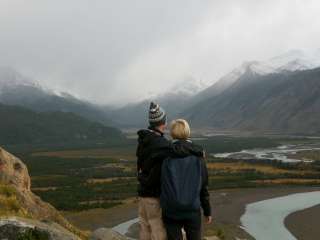 n Argentina have everything ready for us. The starting point for us (and piles of other people) is El Calafate, a town of 18,000 people on the shore of a windy, glacial – and what must be terribly cold in the winter – Lake Argentino. On a clear day, with the Andes sparkling in the background, and the lake reflecting some perfect version of cloudy aquamarine, it reminds me of a blend of Banff and Lake Louise. I felt so at home here, and not just because of the steak nor the quaint stores and chocolate shops on Main Street nor the chilled air or fresh breeze, it was the people that reminded me of home. Half-tourist, half-outdoor folk, with a lot of hotels and restaurants to keep us all mingling.
n Argentina have everything ready for us. The starting point for us (and piles of other people) is El Calafate, a town of 18,000 people on the shore of a windy, glacial – and what must be terribly cold in the winter – Lake Argentino. On a clear day, with the Andes sparkling in the background, and the lake reflecting some perfect version of cloudy aquamarine, it reminds me of a blend of Banff and Lake Louise. I felt so at home here, and not just because of the steak nor the quaint stores and chocolate shops on Main Street nor the chilled air or fresh breeze, it was the people that reminded me of home. Half-tourist, half-outdoor folk, with a lot of hotels and restaurants to keep us all mingling.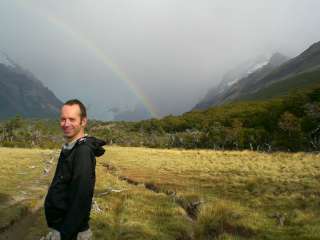 In the three days we were there, the sun shone for approximately five minutes, and the rest of the time it was either grey sky with gale force winds or rainy or both. Mostly both. However, with such a short time there, we couldn’t afford to wait for the weather and so we set out with a woman we met from Iowa and a fellow from Sydney to see Cerro de Torre. It turned out to be a lovely hike through forested area, which kept the wind and rain at bay, and we come upon some gorgeous views…
In the three days we were there, the sun shone for approximately five minutes, and the rest of the time it was either grey sky with gale force winds or rainy or both. Mostly both. However, with such a short time there, we couldn’t afford to wait for the weather and so we set out with a woman we met from Iowa and a fellow from Sydney to see Cerro de Torre. It turned out to be a lovely hike through forested area, which kept the wind and rain at bay, and we come upon some gorgeous views…